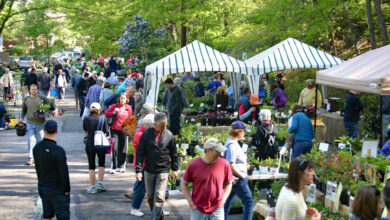Getting Into Nature – Often the Best Therapy
Northern Virginia offers many places for outdoor adventures and experts say that the risk of contracting the coronavirus is less likely outside than inside!

Alexandria, VA – In 1947, Louis Halle often rose before down and biked from Washington, D.C., through Alexandria to Dyke Marsh, just south of the city. He marveled at the outside world, the waterfowl on the river, the smell of fresh loam, the “invisible orchestra” of birds “coming in chorus from every direction, the immeasurable richness and continuance of life.”
“The door stands open on the outside world,” Halle wrote in his book, Spring in Washington. Today, many quarantine-weary people who’ve been living under the coronavirus cloud since mid-March are finding respite in the great outdoors. In fact, as Halle realized in 1947, getting outside is not just about relief from cabin fever, it is good therapy.
“Spending time in natural environments increases physical activity and stimulates the parasympathetic autonomic nervous system, hence decreasing the risk of developing chronic disease,” reports the Park Rx website, an organization that promotes prescribing nature to improve mental and physical health.
A 2019 Danish study likewise found that the natural environment enhances mental health. Lead author Kristine Engemann observed that children who grow up in green surroundings have 55 percent less risk of developing depression, eating disorders, anxiety, and other psycho-social problems.
Northern Virginia offers many places for outdoor adventures and experts say that the risk of contracting the coronavirus is less likely outside than inside because there’s more space to distance oneself from others and there’s more dynamic airflow.
For July, we have identified many locations in our local area where you can take advantage of natural stress reduction in the great outdoors.
Dora Kelly Nature Park
Bullfrogs, green frogs, red slider turtles, and spotted salamanders make their home in the one acre (or so) wetland of Dora Kelly Nature Park in Alexandria’s West End. Marsh plants like pickerelweed and jewelweed flourish as delicate aerialists – dragonflies – whiz around and mate in flight at the height of summer. The wetland is part of a 50-acre woodland preserve, a green respite in the Holmes Run Stream Valley Gorge behind North Beauregard Street’s apartments and townhouses.
Jones Point
On the south end of Old Town Alexandria, Jones Point is known for its 1856 lighthouse, the only remaining riverine lighthouse in Virginia, but it’s also a place for a casual meander to explore human and natural history. The National Park Service reports that in the 1800s, people escaped the city’s “noisy, smelly, and congested industrial center,” to picnic, fish, swim, and relax there. Today, people picnic, bike and walk the trail, play on the fields, launch canoes, and kayaks, and cast for catfish and eels off the fishing pier. The first cornerstone for the District of Columbia was erected on the point in 1791 and in World War I, a shipyard built nine freighters on the point.
Mount Vernon Trail
The 18-mile, paved Mount Vernon Trail stretches from Theodore Roosevelt Island to Mount Vernon Estate, paralleling the Potomac River and the George Washington Memorial Parkway. It connects to four regional trails and along the trail are many places to stop, like the Turkey Run Park, Lady Bird Johnson Park, Gravelly Point, and Fort Hunt Park.
Dyke Marsh Wildlife Preserve
The Mount Vernon Trail south of Alexandria goes through the Dyke Marsh Wildlife Preserve, a freshwater, tidal marsh, home to 300 known species of plants,
38 fish, 34 mammals, and over 270 species of birds. When adding it to the national park system in 1959, Congress directed that “fish and wildlife development and their preservation as wetland wildlife habitat shall be paramount.”
This past spring, many delighted in watching barred owls, bald eagles, and pileated woodpeckers raise their young, as a turkey ambled by. On a one-mile walking trail and the bicycle trail, visitors can explore wetlands, woodlands, and river, the but the best way to see the innards of the marsh is in a canoe, available for rent at Belle Haven Marina.
Huntley Meadows Park
Turtles, beavers, frogs, toads, wading birds, waterfowl, songbirds and raptors, all seem to vie for attention at this 1,500-acre park nestled in an ancient river channel in suburban Fairfax County. In its 50-acre wetland, with hawks often soaring above and honking geese coming in for a landing, from the boardwalk and observation tower visitors can see beaver lodges or ramble through the woods. A true natural gem, the park’s flora include water-loving plants like buttonbush, swamp rose, and lizard’s tail. (The visitor center has been closed since March due to the coronavirus. Check the Fairfax County Park Authority for a reopening date.)
Potomac Gorge
One of the Washington area’s most significant natural wonders is the 15-mile Potomac Gorge, near McLean, where the river plummets 150 feet and surges through a narrow gorge and over a series of bedrock terraces to become the Great Falls of the Potomac. In addition to its powerful currents and roiling, plunging water, the gorge is known for a high concentrations of globally rare natural communities and is one of the most biologically significant natural areas in the eastern United States and in the national park system.
Theodore Roosevelt Island
It’s not exactly island hopping, but outdoor types can explore an island of wilderness in the middle of the Potomac – Theodore Roosevelt Island. Though under National Airport’s flight path and only 10 minutes from downtown Washington, it’s a peaceful, 88-acre patch of woods, wetlands, and shoreline, one-half mile long and one-fourth mile wide. A trail loops through the swamp’s cypresses, trees with “knees,” offering glimpses of waterfowl amid reeds and wetland vegetation. On the north end looms a statue of lifelong naturalist, Teddy Roosevelt, the 26th president.
Mason Neck State Park and National Wildlife Refuge
The Mason Neck State Park and Mason Neck National Wildlife Refuge sit side by side in southern Fairfax County, offering trails, a canoe launch, 12 miles of shoreline, dense woodlands, and two marshes. Bald eagles raised eaglets in 27 nests there this year and up to 60 bald eagles typically winter on Mason Neck. Sharp-eyed observers can watch these large raptors swoop down and grab an unsuspecting fish from the river with their powerful talons. The refuge also has one of the largest great blue heron rookeries in the mid-Atlantic.
Occoquan National Wildlife Refuge
Where the Potomac and Occoquan Rivers converge lies the Occoquan Bay National Wildlife Refuge, 655 acres of grassland, shrubland, marshes, meadows, and open water. This relatively small area includes many different habitats and visitors can see songbirds, raptors, waterfowl, butterflies, dragonflies, and more along the four-mile walking trail and two-mile wildlife drive.
Places of natural beauty are valuable in their own right, but during the disquieting coronavirus era, they can provide what some call ecotherapy. Take a mental health walk nearby, engage all your senses, and stay safe.
New Bill to Fund Parks Backlog
On the morning of June 22, Sen. Mark Warner (D-VA) spoke before a small crowd of journalists and environmental groups at Belle Haven Park. He announced that on June 19, the Great American Outdoors Act had passed in the U.S. Senate on a bipartisan 73-25 vote.
The bill would fully and permanently fund the Land and Water Conservation Fund (LWCF) at $900 million a year and allocate $9.5 billion over five years to address the maintenance backlog on federal public lands, including national parks, refuges, and forests. The National Park Service has a $12 billion maintenance backlog; Virginia parks, $1.1 billion; the George Washington Memorial Parkway, $717 million.
Both Virginia Senators Mark Warner and Tim Kaine voted for the bill. Senator Warner was a lead sponsor and has called on the House of Representatives to send it to President Donald Trump before the nation’s birthday, July 4th. Supporters say that the bill will provide 10,000 jobs in Virginia, 100,000 in the country.
In his closing remarks, Warner echoed the words of LWCF representatives in attendance by saying “We need to take those moments of stillness and [quiet and] recognize a part of our history, a part of our heritage, a part of who we are as Americans. We need to value it, preserve it, maintain it, and make sure that we pass it on to our kids and grandkids.”
To Learn More
Check these websites for current public access information and COVID-19 guidance:
George Washington Memorial Parkway
Mason Neck State Park and Mason Neck National Wildlife Refuge










One Comment